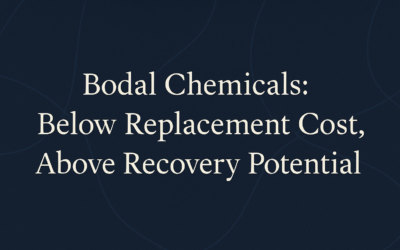Sterlite Technologies (STL) is at an important juncture in its evolution—and in the broader industry cycle it operates in. Over the last decade, STL has transitioned from a domestic manufacturer of fiber optic cables into a global player in the digital infrastructure space, supplying optical fiber, interconnect products, and high-performance connectivity solutions to telecom and cloud customers across more than 100 countries.
Like many companies in cyclical industries, STL’s journey hasn’t been linear. After several years of strong growth leading up to FY2019, STL faced a combination of industry slowdown, global supply-demand imbalances, and internal execution challenges. Profitability declined, working capital requirements rose, and investor sentiment cooled.
In April 2025, STL completed the long-anticipated demerger of its Global Services division (now STL Networks). This move separates the low-margin, project-heavy services business from STL’s high-margin core manufacturing operations—giving both entities the room to pursue focused strategies. Management described this step as a way to sharpen execution and improve capital discipline. Early signs suggest that a leaner, more focused STL is now emerging.
Meanwhile, industry conditions are beginning to shift.
After nearly two years of oversupply and demand softness—particularly in the U.S. and Europe—there are signs that the global fiber cycle is approaching a bottom. Wendell Weeks, CEO of Corning Inc., one of the world’s largest fiber producers, remarked in a recent earnings call: “We believe inventory destocking in optical communications is nearing an end, and customers are beginning to return to normalized ordering patterns.” STL’s management has echoed this view, pointing to recovery beginning as early as Q2 FY25, particularly in data center connectivity and broadband infrastructure projects.
Today, STL is operating at 50–60% capacity utilization. With most capex already behind it, the company is well-positioned to benefit from operating leverage. Based on historical asset turnover and normalized margin profiles, STL could support revenue of ₹9,000–10,000 crore and generate ₹800–1,000 crore in profit before tax at full utilization—without needing additional capital investment.
At the same time, STL stands to benefit from broader structural shifts. The ongoing China+1 trend is prompting global telecom and cloud players to diversify their supply chains. STL’s recent investment in a U.S.-based manufacturing facility qualifies it for BEAD (Broadband Equity, Access, and Deployment) program projects, which are expected to prioritize domestic and non-Chinese suppliers.
Of course, risks remain: the fiber industry is cyclical, competitive pressure persists (particularly from Chinese suppliers), and STL’s execution track record—especially in large-scale projects—has been mixed. That said, the company’s recent restructuring, capital reset, and focused approach suggest it is now better aligned for stable returns.
For long-term investors, STL may represent a fundamentally strong business caught in a temporary downcycle—one that is beginning to show signs of reversal.
Industry Landscape and Market Positioning
The optical fiber and cable industry operates in long, multi-year cycles. Demand typically accelerates during network buildouts and infrastructure upgrades—then moderates as telecom operators digest capacity and reset capex. Since 2005, global fiber demand has expanded from under 100 million fiber-kilometers (f-km) to approximately 575 million f-km by 2023, punctuated by several cycles of sharp growth and correction.
The 2009–2011 and 2016–2019 periods were marked by surging capex, driven by 4G deployment and China’s aggressive FTTH (Fiber to the Home) rollout. STL’s EBIT margins during these peaks reached 16–19%. In contrast, demand slowdowns in 2013–2015 and again post-2021 saw margin compression to 5–7%, as prices weakened and capacity utilization declined.
The latest downcycle began in late 2022, as operators in North America and Europe paused orders amidst high inventory levels and tighter financing. STL, like its peers, experienced volume pressure and falling realizations.
However, by 2024, early signs of stabilization are visible. In Corning’s latest earnings call, the company confirmed that customer orders were returning to normalized patterns. Prysmian Group (EU) and YOFC (China) have also pointed to order book normalization and softening price declines.
CRU Group reported that global average selling prices (ASPs) for fiber dropped nearly 28% year-on-year in 2023 due to oversupply. Since then, prices have started to stabilize, particularly in Europe and India, and some capacity rationalization has begun.
Regionally:
- India has remained relatively steady, with support from BharatNet and 5G rollouts.
- North America has seen delays in BEAD deployments but is expected to recover in late FY25.
- Europe is witnessing a rebound in metro and enterprise fiber demand.
- China continues to see oversupply and pricing pressure, but STL has limited exposure there.
Through this cycle, STL has focused on maintaining price discipline and aligning production to market conditions. Its strong order book (~₹9,800 crore as of Q3 FY24) and diversified manufacturing base give it flexibility to respond to demand shifts without engaging in deep discounting.
Strategic Demand Outlook
While industry cyclicality continues, the demand composition for fiber is evolving. STL is well-positioned to serve several fast-growing segments:
AI and Hyperscale Data Centers
As cloud computing and artificial intelligence continue to scale, data center infrastructure is evolving rapidly. AI-based workloads require significantly more internal and external bandwidth than traditional systems. STL estimates that next-generation GPU-based data centers may require 20–30× more fiber per rack than legacy configurations.
With global hyperscale data center capacity expected to double by 2027, fiber demand is poised to grow independently of traditional telecom cycles. STL has been expanding its ribbon cable and ultra-slim fiber offerings to serve this high-density segment.
Public Infrastructure Investment
Government funding will continue to support the next wave of fiber deployment:
- The BEAD program in the U.S., backed by $42 billion, will prioritize local suppliers like STL’s South Carolina plant.
- India’s BharatNet Phase III will extend fiber connectivity to hundreds of thousands of villages.
- Europe’s digital infrastructure goals will require continued metro and FTTH expansion.
Enterprise and Cloud Interconnect
Beyond public and telco networks, enterprise-grade fiber is growing in demand—from banks, media firms, industrial campuses, and healthcare systems. STL’s interconnect portfolio is already deployed in several European and Middle Eastern markets, targeting low-latency and high-throughput use cases.
These developments suggest a more balanced demand base in the years ahead, supported by technology shifts, public infrastructure cycles, and private cloud upgrades.
Competitive Positioning
STL competes with several global fiber manufacturers, each with different geographic and strategic strengths:
- Corning Inc. (USA): ~$4.3 billion in optical revenue, with premium pricing and proprietary technologies; EBITDA margins in the mid-teens.
- Prysmian Group (Italy): A diversified cable major; telecom margins in the 6–12% range.
- YOFC (China): The largest player by volume; export-led, cost-focused, and mostly domestic SOE-driven.
STL is among the top five global producers outside China. Its capacity of 42 million f-km (fiber) and 50 million f-km (cable), coupled with vertically integrated manufacturing and global spread (India, Italy, Brazil, U.S.), makes it cost-competitive and globally relevant.
While STL may lack the R&D intensity of Corning or the scale of YOFC, it consistently outperforms regional players on product margins and delivery flexibility.
Financials and Capital Efficiency
From FY16 to FY23, STL generated over ₹3,200 crore in cumulative free cash flow, while investing more than ₹4,700 crore in expanding capacity and integrating backward into preforms.
Peak ROCE of 30% in FY18 declined to ~10% by FY24, due to:
- Lower pricing and subdued volumes,
- High working capital from service contracts,
- And underutilized capacity during the global downturn.
Post the demerger of STL Networks, financial clarity has improved. The retained product business is:
- Higher margin (16–18% EBITDA in normalized years),
- Capex-light (₹200–300 crore in maintenance annually),
- And better aligned with global demand cycles.
A ₹1,000 crore QIP in FY24 helped reduce net debt to below ₹2,000 crore. STL now targets breakeven at 60–65% utilization—a level it historically exceeded during upcycles.
6. Valuation and Scenario Analysis
At ₹82 per share, STL trades at:
- Market Cap: ₹4,100 crore
- Enterprise Value (EV): ₹6,300 crore
- EV/Sales (LTM): ~0.8×
Current utilization remains around 50–60%. Based on historical turnover ratios and cost structure, STL could generate ₹9,000–10,000 crore in revenue at full capacity. With 18–20% EBITDA margins, this could translate to ₹800–1,000 crore in pre-tax earnings—without further investment.
This implies a normalized P/E of 4–5× and EV/EBITDA of 4.0–5.2×, significantly below global peers. STL’s current EV is close to the replacement cost of its global capacity base, offering a margin of safety while providing upside if utilization improves.
Key Risks
- Industry Cyclicality: A prolonged downcycle or slower-than-expected BEAD execution could impact asset utilization.
- Pricing Pressure: Competition from Chinese producers could compress margins, especially in exports.
- Execution Risk: New product rollouts (e.g., for data centers) and contracts carry delivery and scale-up risks.
- Capital Allocation and Governance: Past concerns around promoter pledging and return on incremental capex remain.
- Trade and Regulatory Shifts: Policy changes, tariffs, or local sourcing rules could affect STL’s ability to serve certain markets.
Conclusion
Sterlite Technologies has emerged from a complex phase of growth, diversification, and strategic reset. With the services demerger now complete and capex largely behind it, the company’s structure is simpler, margins are better insulated, and utilization remains the key trigger.
The demand backdrop is gradually improving, led by structural shifts in AI, broadband connectivity, and enterprise infrastructure. STL’s global reach, competitive cost base, and local eligibility in key programs like BEAD give it a viable path to recovery.
While risks exist, current valuations reflect a conservative view of the future. For investors with a medium-term horizon, STL offers exposure to critical infrastructure themes at a point where fixed costs are high, but marginal returns could be significant.
As the cycle turns, Sterlite Technologies has the tools, assets, and strategy to participate in the next leg of growth.
Disclaimers
This blog has been prepared by Amaltas Asset Management LLP, a SEBI-registered Portfolio Management Service (PMS) with registration number INP00009126. It is intended solely for private distribution to the recipient and should not be reproduced, redistributed, or shared without prior written consent of Amaltas Asset Management LLP. The views and information contained in this document are for informational purposes only and do not constitute investment advice or a recommendation to buy, sell, or hold any security or financial instrument. The material is based on information that is believed to be reliable but has not been independently verified. Amaltas Asset Management LLP does not represent or warrant the accuracy or completeness of any information contained herein. This document is not an offer or solicitation for investment in any product or strategy managed or advised by Amaltas Asset Management LLP. Investors are advised to consult their financial advisors before taking any investment decisions. Amaltas Asset Management LLP, its employees, and clients may have exposure to the securities mentioned in this report. The firm may also undertake transactions contrary to the views expressed herein. Past performance is not indicative of future results. All investments are subject to market risks, including possible loss of capital.
SEBI Regulatory Disclosures
- This report has been prepared in compliance with SEBI (Portfolio Managers) Regulations, 2020 and other applicable laws.
- Amaltas Asset Management LLP has not received any compensation from the companies mentioned in this report in the last 12 months.




